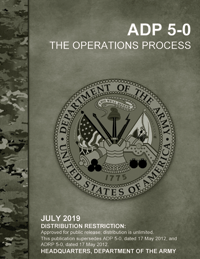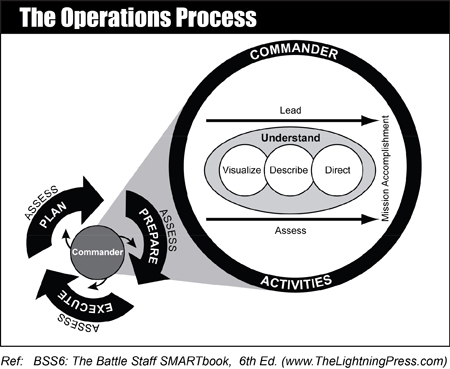 Army Doctrine Publication (ADP) 5-0, The Operations Process (July 2019) provides doctrine on the operations process. It describes fundamentals for effective planning, preparing, executing, and assessing operations. It describes how commanders, supported by their staffs, employ the operations process to understand situations, make decisions, direct action, and lead forces to mission accomplishment.
Army Doctrine Publication (ADP) 5-0, The Operations Process (July 2019) provides doctrine on the operations process. It describes fundamentals for effective planning, preparing, executing, and assessing operations. It describes how commanders, supported by their staffs, employ the operations process to understand situations, make decisions, direct action, and lead forces to mission accomplishment.
ADP 5-0 defines and describes the operations process. Military operations are human endeavors conducted in dynamic and uncertain operational environments to achieve a political purpose. Army forces, as part of a joint team, conduct unified land operations to shape operational environments, prevent conflict, consolidate gains, and contribute to winning the Nation’s wars. During periods of competition or armed conflict, command and control—the exercise of authority and direction by a properly designated commander—is fundamental to all operations. Based on the Army’s vision of war and nature of operations, mission command is the Army’s approach for exercising command and control. The mission command approach empowers subordinate decision making and emphasizes decentralized execution appropriate to the situation.
The Operations Process
The Army’s framework for organizing and putting command and control into action is the operations process—the major command and control activities performed during operations: planning, preparing, executing, and continuously assessing the operation. Commanders use the operations process to drive the conceptual and detailed planning necessary to understand their operational environment (OE); visualize and describe the operation’s end state and operational approach; make and articulate decisions; and direct, lead, and assess operations.
Commanders, staffs, and subordinate headquarters employ the operations process to organize efforts, integrate the warfighting functions across multiple domains, and synchronize forces to accomplish missions. This includes integrating numerous processes and activities such as information collection and targeting within the headquarters and with higher, subordinate, supporting, and supported units. The unit’s battle rhythm helps to integrate and synchronize the various processes and activities that occur within the operations process.
A goal of the operations process is to make timely and effective decisions and to act faster than the enemy. A tempo advantageous to friendly forces can place the enemy under the pressures of uncertainty and time. Throughout the operations process, making and communicating decisions faster than the enemy can react produces a tempo with which the enemy cannot compete. These decisions include assigning tasks; prioritizing, allocating, and organizing forces and resources; and selecting the critical times and places to act. Decision making during execution includes knowing how and when to adjust previous decisions. The speed and accuracy of a commander’s actions to address a changing situation is a key contributor to agility.
Activities of the Operations Process
The activities of the operations process are not discrete; they overlap and recur as circumstances demand. Planning is the art and science of understanding a situation, envisioning a desired future, and laying out effective ways of bringing that future about. Preparation consists of those activities performed by units and Soldiers to improve their ability to execute an operation. Execution is the act of putting a plan into action by applying combat power to accomplish the mission and adjusting operations based on changes in the situation. Assessment is a continuous activity that supports decision making by ascertaining progress of the operation for the purpose of developing and refining plans and for making operations more effective.
The operations process (ADP 5-0, 2019) is covered extensively in BSS6: The Battle Staff SMARTbook, 6th Ed. (Plan, Prepare, Execute, & Assess Military Operations) Material referenced includes 12 pages of the fundamentals of the operations process, 14 pages on commander’s activities (understand, visualize, describe, direct, lead, assess), 20 pages on planning, 6 pages on preparation, 12 pages on execution, and 6 pages on assessment. BSS6: The Battle Staff SMARTbook, 6th Ed. covers the operations process (ADP 5-0); commander’s activities; Army planning methodologies; the military decisionmaking process and troop leading procedures (FM 6-0 w/Chg 2: MDMP & TLP); integrating processes (IPB, information collection, targeting, risk management, and knowledge management); plans and orders (WARNORDs/FRAGORDs/OPORDs); mission command, C2 warfighting function tasks, command posts, liaison (ADP 6-0); rehearsals & after action reviews; and operational terms and military symbols (ADP 1-02).
 This article is an extract from “BSS6: The Battle Staff SMARTbook, 6th Ed. (Plan, Prepare, Execute, & Assess Military Operations)” by The Lightning Press. Download a free PDF sample and learn more at: BSS6: The Battle Staff SMARTbook, 6th Ed. (Plan, Prepare, Execute, & Assess Military Operations).
This article is an extract from “BSS6: The Battle Staff SMARTbook, 6th Ed. (Plan, Prepare, Execute, & Assess Military Operations)” by The Lightning Press. Download a free PDF sample and learn more at: BSS6: The Battle Staff SMARTbook, 6th Ed. (Plan, Prepare, Execute, & Assess Military Operations).
Browse additional military doctrine articles in our SMARTnews Blog & Resource Center.
About The Lightning Press SMARTbooks. Recognized as a “whole of government” doctrinal reference standard by military, national security and government professionals around the world, SMARTbooks comprise a comprehensive professional library. SMARTbooks can be used as quick reference guides during operations, as study guides at education and professional development courses, and as lesson plans and checklists in support of training. Browse our collection of Military Reference SMARTbooks to learn more.ary Reference SMARTbooks to learn more.














































